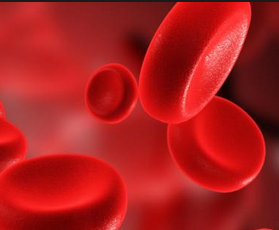Characteristics of red blood cells
Erythrocytes are red in color. They are made up of a protein known as hemoglobin, which has red iron. This red iron explains why our blood is red in color. Red blood cells are round in shape. When erythrocytes are normal, they are doughnuts shaped with holes at the center. Hemoglobin gives these cells the round shape, which increases surface area for absorption of oxygen allowing them to transport more oxygen.
Erythrocytes are rubber like. They are very smooth and are able to bent easily. This enables them to move at a faster rate in our blood and penetrate through relatively small vessels in various parts of the body.
Erythrocytes – function
Red blood cells or erythrocytes are the most common blood cells in the body. These cells do not have a nucleus, which means they are anucleated. This offers more space for storage of hemoglobin. Hemoglobin is the respiratory pigment in the body that binds to carbon dioxide and oxygen allowing them to be transported in and out of tissues. Hemoglobin has iron, which combines with oxygen giving blood the red color.
Mechanism of gas transport in the blood
Oxygen is transported in the body through two main ways. Most often, oxygen molecules attach themselves to hemoglobin molecules. This process takes place inside the red blood cells forming oxyhemoglobin, which is transported to various tissues through the blood.
However, not all oxygen is transported through the hemoglobin. Small amounts of oxygen are dissolved in the blood plasma and channeled to various parts. Most of the carbon IV oxide is transported as bicarbonate ions in the blood. However, about thirty percent carbon dioxide is bound to hemoglobin in the red blood cells.
Carbon dioxide and oxygen bind to hemoglobin at different locations in the red blood cells during transportation. This takes place to avoid interference with oxygen transport.
Erythrocytes – lifespan
Their life is limited to about 120 days. They lack a nucleus among other cellular machinery hence when damaged, they’re not able to repair themselves. The repair, removal and drying of old red blood cells are done by the spleen. Despite the fact that erythrocytes are the most abundant cells in the body, they die at a very high rate. Every second, two to three million of these cells die. As a result, the body must constantly produce more of these cells to ensure that their production and death equals. Erythrocytes are manufactured through a process known as erythropoiesis.
Erythropoiesis
The body has a mechanism for assessing the concentration of blood cells in the blood so that their production rate matches the needs of the body. The production and regulation of RBCs in the body is called erythropoiesis. This process occurs in association of certain hormones and other cells.
The kidney is responsible for monitoring the level of oxygen in our blood. When the level of oxygen is low, the kidney produces a hormone know as erythropoietin. This hormone penetrates into the blood and is transported to all parts of the body. All the cells are open to this hormone but red bone marrow cells are the only cells that react to such hormone as they have receptor cells.
Erythropoietin stimulates the bone marrow to produce erythrocytes. The erythrocytes then leave the red bone marrow and penetrate to the blood. The increase in erythrocytes leads to increase in oxygen-carrying capacity. When the oxygen levels are appropriate, the kidney senses it and slows down the rate of production of erythropoietin. This feedback mechanism helps ensure that the population of the erythrocytes is always constant and the supply of oxygen in the body matches the needs of the cells.
Red blood cell count
Red blood cell count refers to a medical test that doctors carry out to determine the number of red blood cells present in one’s blood. The test is also referred to as an erythrocyte count. The test is vital as erythrocytes contain hemoglobin, which transports oxygen to various tissues. The number of red blood cells determines how much oxygen tissues will receive. Oxygen is vital for proper functionality of body tissues.
Normal Erythrocytes Range
The definition of high or low blood cell count is relative depending on medical practice. However, the normal range of RBCs count in adults is 700,000 to 5.2 million RBCs per mcl in men and for women, the normal range is considered to be between 500,000 and 4.6 million RBCs per microliter. In children, the appropriate range differs depending on age and sex.
High Erythrocytes – Causes
High erythrocytes or high red blood cell count is triggered by reasons like reduced oxygen levels, kidney issues, performance enhancing drugs; etc. Low oxygen levels can make the body increase red blood cell production for cases like heart failures, congenital heart conditions,smoking, COPD, pulmonary fibrosis, sleep apnea, hemoglobinopathy (condition that impairs oxygen transmission capacity of RBCs) and high altitudes. Dehydration, marked by a condition in which the liquid portion of the blood or plasma is reduced, results in the concentration of red blood cell count (even though the count remains the same).
